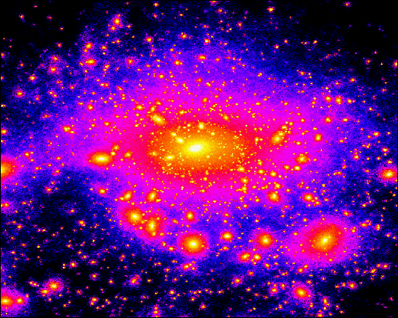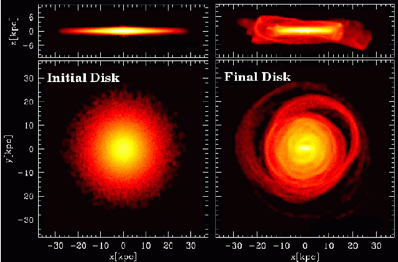
Milky Way will be 'puffed up', not ripped apart
DR EMILY BALDWIN
ASTRONOMY NOW
Posted: September 1, 2009


New computer simulations conducted by Ohio State University astronomers suggest that the Milky Way will meet its fate by being 'puffed up' rather than ripped apart.
The fate of our Milky Way Galaxy has long been thought to lie in future collisions with our neighbouring galaxies, such as the massive Large and Small Magellanic Clouds, which will rip our Galaxy apart. A new study conducted by Ohio State University astronomer Stelios Kazantzidis and colleagues suggests that we may escape this torturous demise, instead being "puffed up" around the edges to produce structures known as stellar rings and flares.
 This supercomputer simulation screenshot shows the density of dark matter in our Milky Way Galaxy (blue through to yellow indicates increasing concentrations), with a bright central region corresponding roughly to the Milky Way's luminous matter of gas and stars and the bright clumps indicating dark matter satellites orbiting the Galaxy. Image: Stelios Kazantzidis/Ohio State University.
This supercomputer simulation screenshot shows the density of dark matter in our Milky Way Galaxy (blue through to yellow indicates increasing concentrations), with a bright central region corresponding roughly to the Milky Way's luminous matter of gas and stars and the bright clumps indicating dark matter satellites orbiting the Galaxy. Image: Stelios Kazantzidis/Ohio State University.
The study also shows that the mysterious dark matter component of the Universe plays an important role. Astronomers suspect that all galaxies are embedded within massive and extended halos of dark matter. For example, the Milky Way measures 100,000 light years across but is surrounded by a cloud or 'halo' of dark matter that is one million light-years across.
Kazantzidis et al's simulations plotted the course of a satellite galaxy – such as the Large Magellanic Cloud and its associated dark matter – as it collided with a spiral galaxy such as our own. The result was that as the satellite galaxy slowly disintegrated, its gravity tugged at the larger galaxy’s edge, drawing out stars and other debris, resulting in a flared galactic disc such as that of the Milky Way, which starts out narrow at the centre and then widens toward the edges.
"We can't know for sure what's going to happen to the Milky Way, but we can say that our findings apply to a broad class of galaxies similar to our own," says Kazantzidis. "Our simulations showed that the satellite galaxy impacts don't destroy spiral galaxies – they actually drive their evolution, by producing this flared shape and creating stellar rings – spectacular rings of stars that we’ve seen in many spiral galaxies in the Universe."
 Density maps of disc stars illustrating the global morphological transformation of a galactic disc from an initially stable condition (left) to the final result after bombardment by dark matter substructures (right). The edge-on (upper panels) and face-on (bottom panels) views of the disc are displayed in each frame. Brighter colours indicate regions of higher density of disc stars. Image: Stelios Kazantzidis/ Ohio State University.
Density maps of disc stars illustrating the global morphological transformation of a galactic disc from an initially stable condition (left) to the final result after bombardment by dark matter substructures (right). The edge-on (upper panels) and face-on (bottom panels) views of the disc are displayed in each frame. Brighter colours indicate regions of higher density of disc stars. Image: Stelios Kazantzidis/ Ohio State University.
This is the first time that collisions between spiral galaxies and satellites have been simulated at this level of detail to reveal visible signs of interactions between dark matter and normal matter. "We consider this flaring to be one of the most important observable consequences of interactions between in-falling satellite galaxies and the galactic disc," says Kazantzidis.
Despite conducting numerous collision scenarios of small galaxies onto a larger disc galaxy the outcome was always the same: none of the disc galaxies were torn apart, rather the primary galaxies gradually disintegrated the in-falling satellites, whose material ultimately became part of the larger galaxy. The satellites made repeated passes through the galactic disc, each time giving up some of their mass, a process that would eventually destroy them completely. Though the primary galaxy survived, it did form flared edges which closely resembled our Galaxy’s appearance today.
"We know from cosmological simulations of galaxy formation that these smaller galaxies probably interact with galactic discs very frequently throughout cosmic history," says Kazantzidis. "Since we live in a disc galaxy, it is an important question whether these interactions could destroy the disc. We saw that galaxies are not destroyed, but the encounters leave behind a wealth of signatures that are consistent with the current cosmological model, and consistent with our observations of galaxies in the Universe."
Spiral galaxies have a complex formation and evolutionary history, and astronomers strive to understand exactly how the Milky Way formed and how it will evolve. "We may never succeed in knowing its exact history, but we can try to learn as much as we can about it, and other galaxies like it," concludes Kazantzidis.
|



